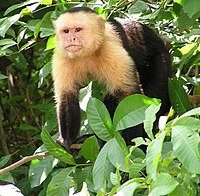
Photo from wikipedia
Capuchins are omnivorous neotropical primates that can survive in urban forests by supplementing their diet with human foods. However, few studies have analyzed the impact of these resources on their… Click to show full abstract
Capuchins are omnivorous neotropical primates that can survive in urban forests by supplementing their diet with human foods. However, few studies have analyzed the impact of these resources on their diet diversity and feeding seasonality. We aimed to assess the patterns of foraging, feeding, and diet diversity of urban capuchins (Sapajus sp.) that live in a tiny urban forest in Foz do Iguaçu, Brazil, where humans frequently feed them. We predicted that forest degradation and human foods could decrease diet diversity, though capuchins may, conversely, reduce their selectivity and expand their food repertoire. We followed the animals from dawn to dusk between May 2018 and April 2019 to list and quantify the species and items consumed. We used diversity indexes and cluster analysis to understand similarities and differences in the diet composition over the study period. We recorded 58 plant species (being 14 exotics) consumed by the monkeys, and nonconventional items, with low diet diversity overall. The diet consisted mainly of plants (69.8%), animal matter (20.6%), and processed foods (9.5%). Capuchins consumed more food from the anthropic environment (57.5%) than from the forest (42.4%), while their food from the forest included more invertebrates (47.8%) than fruits (40%). The cluster analysis showed two main groups of feeding months, in accordance with the seasons of high and low food production in local forests. Monkeys did not vary the frequencies of foraging or feeding between seasons, probably due to the omnipresent availability of human foods. Despite the high consumption of human foods, capuchins responded to the seasonality of the forest, expanding their feeding diversity in the drier period. Future studies should analyze the correspondence between food consumption and local phenology, as well as the potential role of capuchins as seed dispersers in this depauperate community.
Journal Title: American Journal of Primatology
Year Published: 2022
Link to full text (if available)
Share on Social Media: Sign Up to like & get
recommendations!